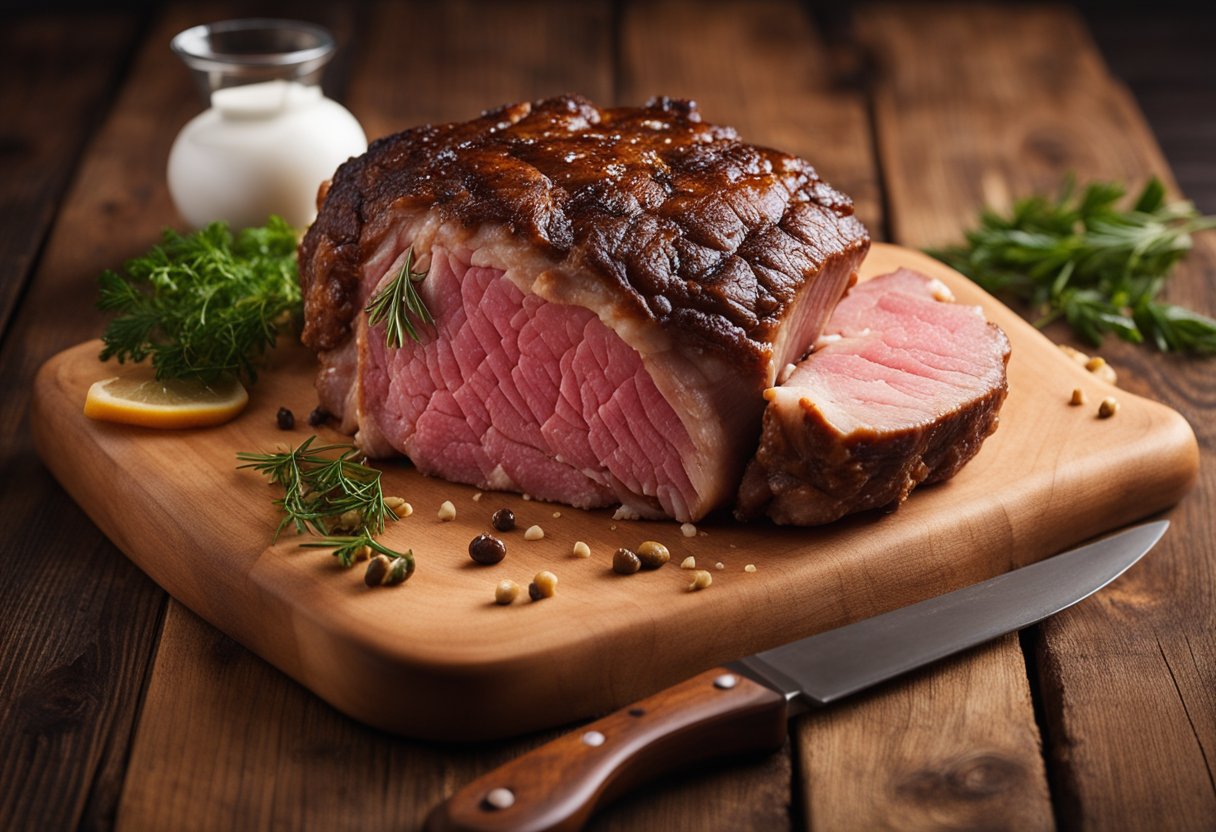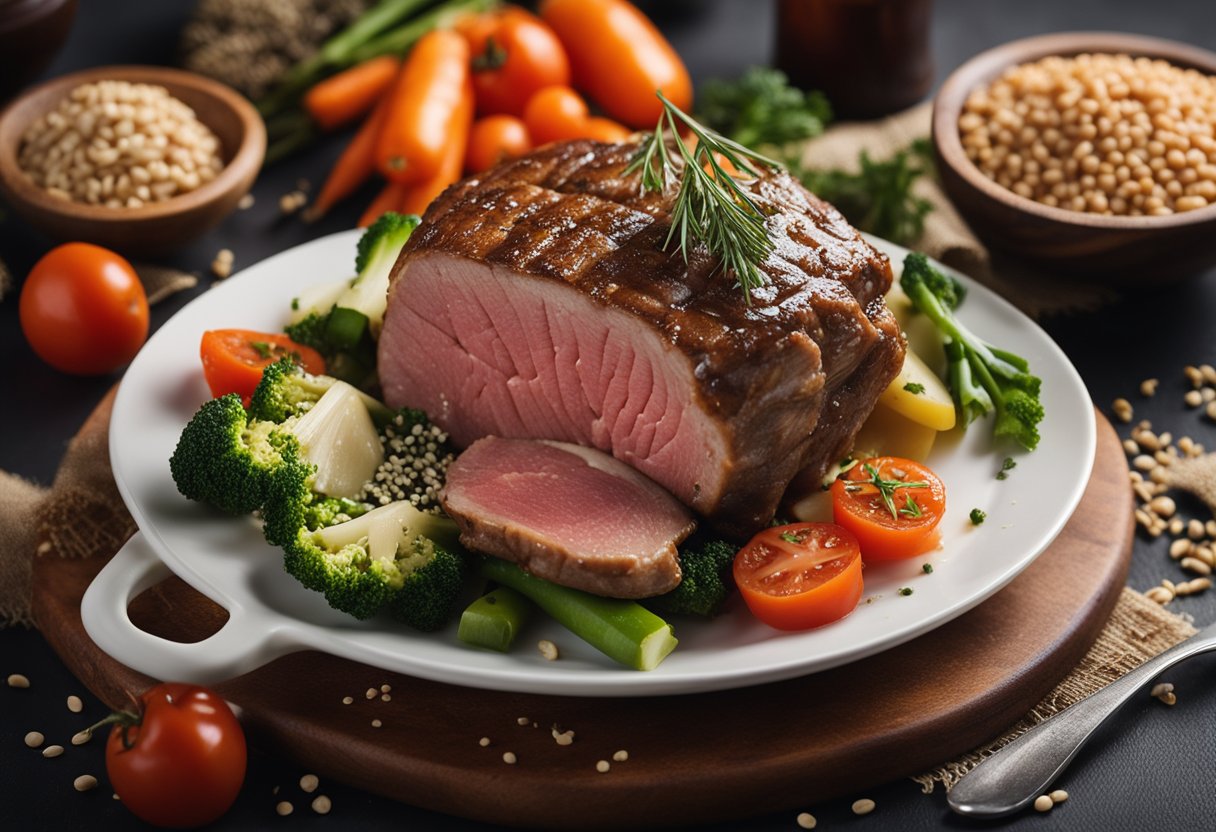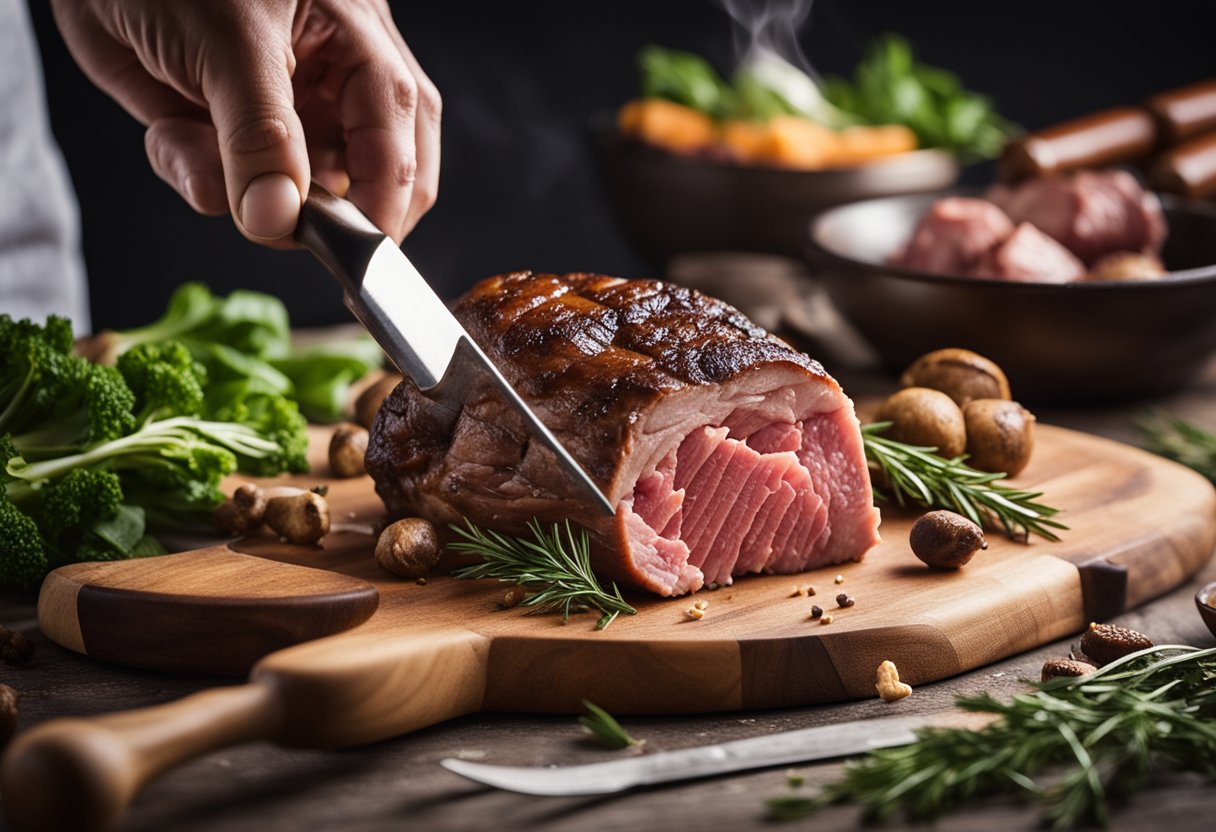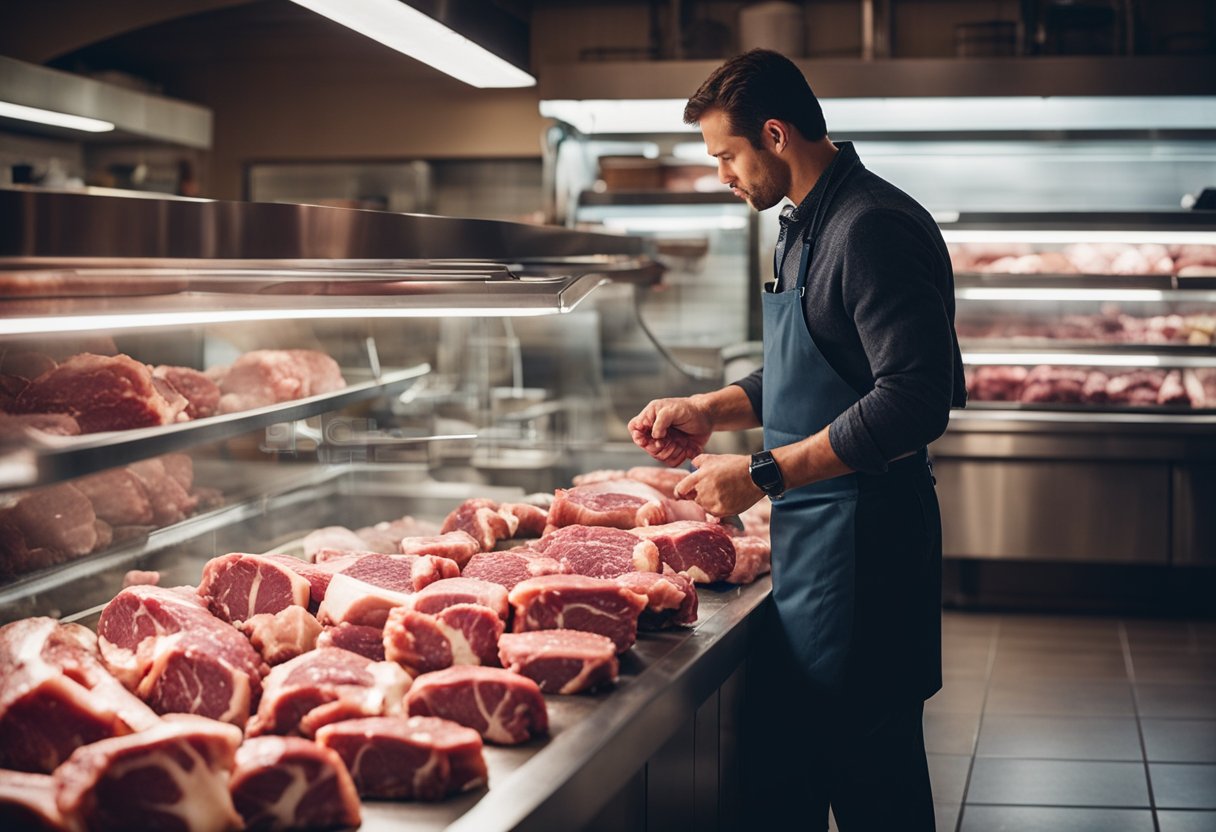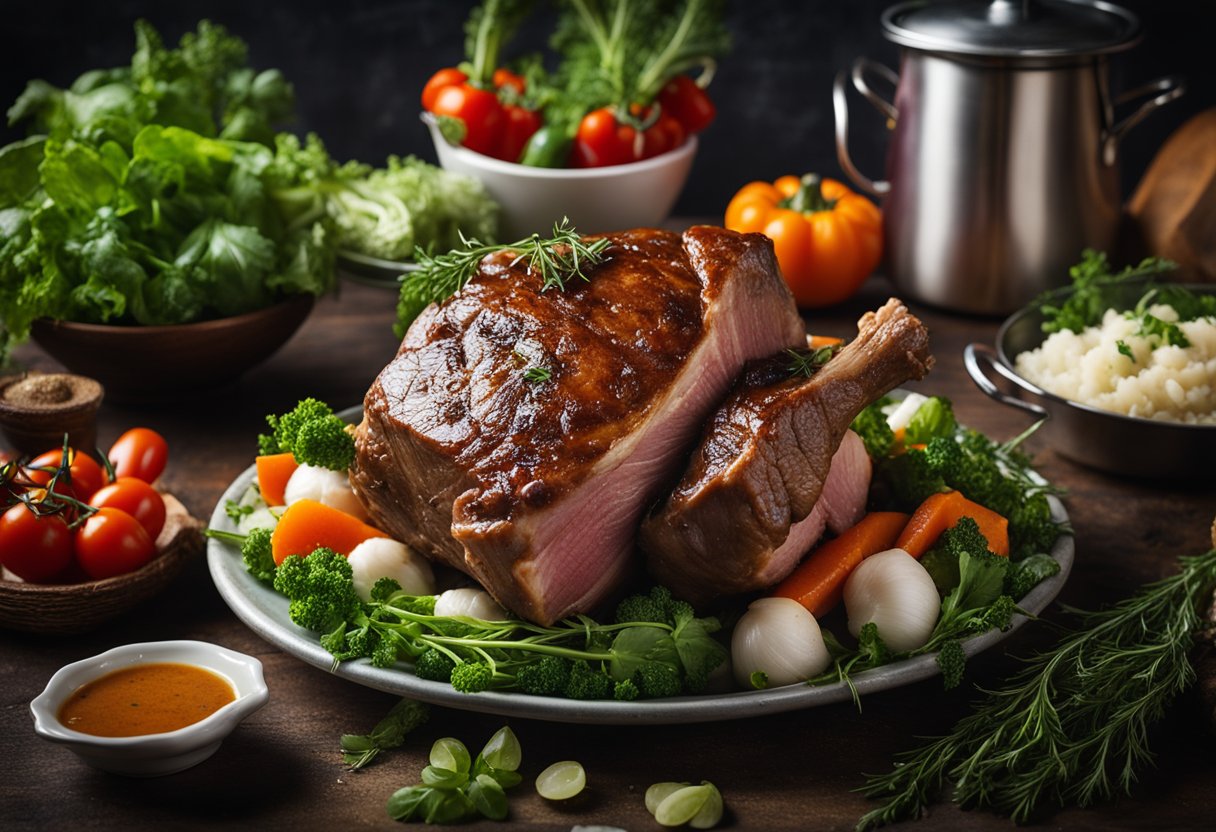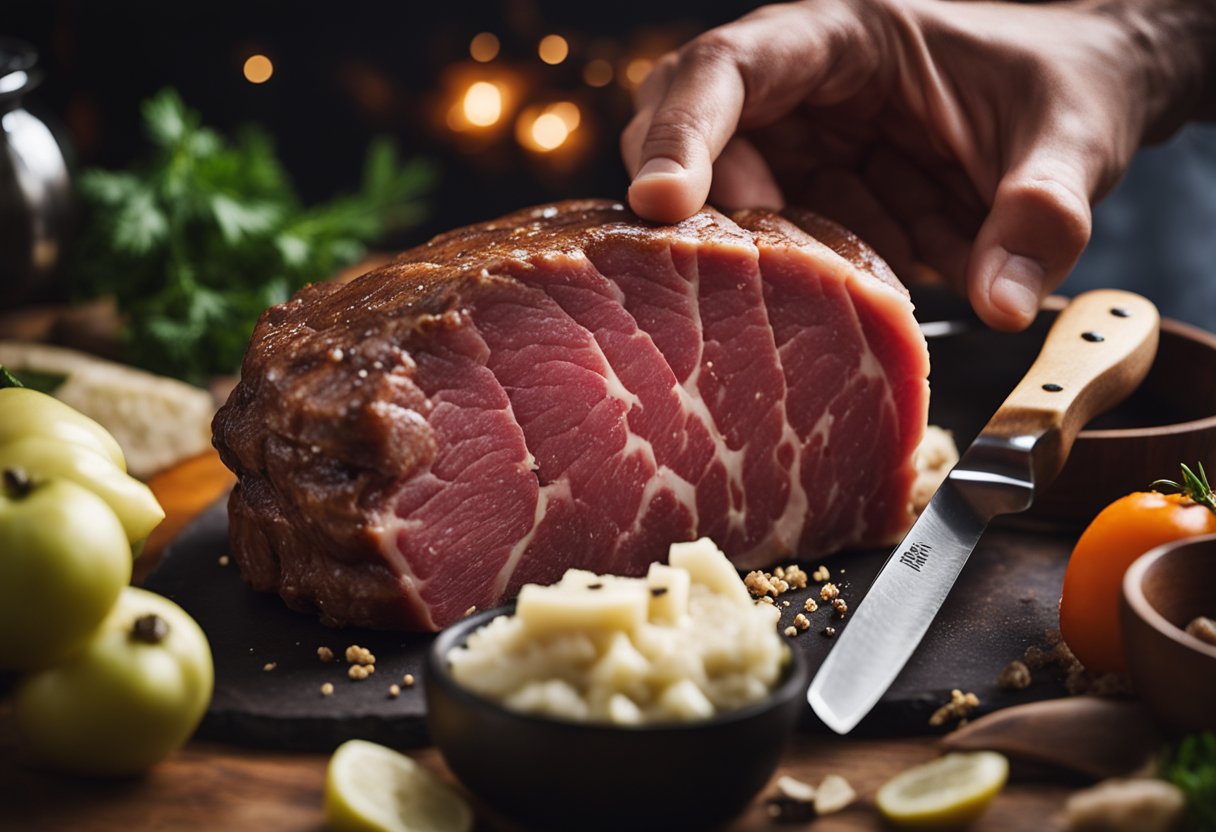Beef knuckle, also known as sirloin tip, is a versatile and flavorful cut of beef that comes from the hindquarters of a cow. It is a lean and moderately tough cut that can be cooked in various ways, including roasts, stews, and stir-fries. If you are looking for a budget-friendly cut of meat that can be used in a wide range of dishes, beef knuckle is a great option.
One of the great things about beef knuckle is that it is easy to prepare. You can trim and cut it into different muscles and steaks, remove the knuckle cap, divide the muscles, trim the connective tissue and fat, and cook it in various ways. Whether you prefer it slow-cooked in a pot roast or grilled as a steak, beef knuckle is a delicious and nutritious choice that can be enjoyed by the whole family.
Beef Knuckle Overview
Definition
Beef knuckle is a sub-primal cut of beef that comes from the round primal cut of the steer. It is located near the rear of the animal and includes the hip and portions of the leg. The beef knuckle is a versatile cut of meat that is lean, flavorful, and affordable. It is also known as the sirloin tip and is situated right above the hock joint, at the lower end of the round.
Cuts and Butchery
The beef knuckle is made up of four main muscles: rectus femoris, vastus intermedius, vastus lateralis, and vastus medialis. These muscles are known to customers in the USA as the tip center, tip side, and tip bottom. The rectus femoris is the largest and most tender muscle in the beef knuckle. It is a long, cylindrical muscle that runs along the center of the knuckle. The vastus intermedius is a thin, flat muscle that lies underneath the rectus femoris. The vastus lateralis and vastus medialis are located on the sides of the knuckle and are less tender than the rectus femoris.
When butchering a beef knuckle, it is important to remove the silver skin and any excess fat. The silver skin is a tough, fibrous membrane that surrounds the muscles and must be removed to prevent toughness in the meat. The beef knuckle can be cut into steaks, roasts, or cubes for stews and stir-fries. It is also a popular cut for making beef jerky due to its leanness and flavor.
Overall, the beef knuckle is a versatile and affordable cut of beef that can be used in a variety of dishes. Its lean meat makes it a healthy choice for those watching their fat intake. With proper butchery and cooking techniques, the beef knuckle can be a delicious addition to any meal.
Nutritional Profile
Beef knuckle is a lean cut of meat that is low in calories and high in protein. It is a great source of essential nutrients like iron, zinc, and vitamin B12. Here is a breakdown of its nutritional profile per 100 grams of cooked beef knuckle:
- Calories: 124
- Protein: 23 g
- Fat: 3.24 g
- Iron: 2.3 mg
- Zinc: 4.5 mg
- Vitamin B12: 2.5 mcg
As you can see, beef knuckle is a great source of protein, which is essential for building and repairing muscle tissue. It is also low in calories and fat, making it a great choice for those who are trying to lose weight or maintain a healthy weight.
In addition to protein, beef knuckle is also a good source of iron, which is important for healthy blood cells and oxygen transport throughout the body. It also provides zinc, which is important for immune system function and wound healing. Vitamin B12 is another important nutrient found in beef knuckle, which is essential for nerve function and the production of red blood cells.
Overall, beef knuckle is a nutritious and healthy cut of meat that can be enjoyed as part of a balanced diet.
Culinary Uses of Beef Knuckle
Preparation Techniques
Beef knuckle is a versatile cut of meat that can be used in a variety of dishes. Before cooking, it is important to properly prepare the meat. To do this, you should remove any excess fat and silver skin from the meat. You can also marinate the beef knuckle to add additional flavor.
Cooking Methods
Beef knuckle is a lean cut of meat and requires long, slow cooking methods in moist environments to become tender. Braising, stewing, and roasting are some of the most popular cooking methods for beef knuckle. You can also grill or pan-sear the meat for a delicious crust on the outside.
Popular Recipes
Beef knuckle can be used as stroganoff, a Russian dish made with sour cream and mushrooms. You can also use beef knuckle to make a Sunday red sauce or as ground beef for burgers or meatballs.
Overall, beef knuckle is a versatile and flavorful cut of meat that can be used in a variety of dishes. With proper preparation and cooking techniques, you can create delicious and satisfying meals with this cut of meat.
Buying Guide
Selection Criteria
When buying beef knuckle, there are a few things you should consider to ensure you get the best quality product. Here are some selection criteria to keep in mind:
- Color: Look for beef knuckle that has a bright red color. This indicates that the meat is fresh and has not been exposed to too much oxygen.
- Marbling: Marbling refers to the small white flecks of fat that are dispersed throughout the meat. Look for beef knuckle that has a good amount of marbling, as this will help keep the meat moist and tender during cooking.
- Texture: The meat should feel firm to the touch and not too soft or mushy. This indicates that the meat is fresh and has not been sitting around for too long.
Storage Tips
Proper storage is key to keeping your beef knuckle fresh and safe to eat. Here are some tips to help you store your beef knuckle:
- Refrigeration: Beef knuckle should be stored in the refrigerator at a temperature between 32°F and 40°F. Make sure to keep the meat in its original packaging or wrap it tightly in plastic wrap to prevent air from getting in.
- Freezing: If you’re not planning on using your beef knuckle right away, you can freeze it for later use. Make sure to wrap the meat tightly in plastic wrap or aluminum foil before placing it in the freezer. Beef knuckle can be stored in the freezer for up to six months.
- Thawing: When you’re ready to use your frozen beef knuckle, make sure to thaw it in the refrigerator. This will help prevent the growth of harmful bacteria. Allow the meat to thaw for at least 24 hours before cooking.
Health Benefits
Beef knuckle is not only delicious but also packed with nutrients that offer a range of health benefits. Here are a few reasons why you should consider adding beef knuckle to your diet:
1. Rich in Protein
Beef knuckle is an excellent source of protein, which is essential for building and repairing tissues in your body. A 3-ounce serving of beef knuckle contains around 20 grams of protein, making it an ideal food choice for those looking to increase their protein intake.
2. Contains Collagen and Gelatin
Beef knuckle is rich in collagen and gelatin, which are known to improve skin health, joint health, and gut health. Collagen and gelatin are also essential for maintaining healthy bones and teeth.
3. Supports Muscle Growth
Beef knuckle is also rich in amino acids, including leucine, which is known to support muscle growth and repair. Eating beef knuckle regularly can help you build and maintain lean muscle mass.
4. Boosts Immune System
Beef knuckle contains a range of vitamins and minerals, including zinc, which is known to boost the immune system. Zinc is also essential for wound healing and maintaining healthy skin.
5. Supports Healthy Digestion
Beef knuckle is an excellent source of dietary fiber, which is essential for maintaining healthy digestion. A diet rich in fiber can help prevent constipation, reduce the risk of colon cancer, and improve overall gut health.
Overall, beef knuckle is an excellent addition to a healthy and balanced diet. Its nutrient-rich profile makes it a great food choice for those looking to improve their health and well-being.
Internal Links
When it comes to beef cuts, the beef knuckle is one of the most versatile and flavorful sub-primal cuts that you can use in a variety of recipes. If you’re looking for some inspiration, you can check out Gourmet Martha’s garlic beef noodle bowls recipe that uses beef knuckle as the main ingredient. The recipe combines the tender beef with garlic, ginger, and soy sauce to create a delicious and satisfying meal.
If you’re wondering what other ingredients you can add to ground beef when cooking, Gourmet Martha’s what should I add to ground beef when cooking article has some great tips. For instance, adding onions, garlic, and Worcestershire sauce can enhance the flavor of the beef and make it more savory.
Another great recipe that uses beef knuckles is Gourmet Martha’s beef enchilada casserole recipe. The recipe combines the beef with enchilada sauce, tortillas, and cheese to create a delicious and hearty casserole that’s perfect for a family dinner.
If you’re in the mood for something more Asian-inspired, Gourmet Martha’s beef and broccoli stir-fry recipe is a great option. The recipe combines the beef with broccoli, garlic, ginger, and soy sauce to create a flavorful and healthy stir-fry that’s perfect for a quick and easy weeknight meal.
Finally, if you’re looking for a unique twist on macaroni and cheese, Gourmet Martha’s macaroni and cheese with ground beef, salsa, and green chiles recipe is a great option. The recipe combines beef with macaroni, cheese, salsa, and green chiles to create a spicy and cheesy dish that’s perfect for a potluck or family gathering.
Food Safety and Handling
When it comes to beef knuckle, proper food safety and handling is crucial to prevent foodborne illnesses. Here are some guidelines to keep in mind:
Is beef knuckle good to be stored?
Storing beef knuckle properly is important to prevent the growth of harmful bacteria. The USDA recommends storing beef in the refrigerator at a temperature of 40°F or below. It is important to keep beef separate from other foods to prevent cross-contamination. You can store beef in its original packaging if it will be used within a few days, or you can transfer it to an airtight container or freezer-safe bag and store it in the freezer for longer storage.
Cooking Temperatures
Cooking beef knuckle to the proper temperature is essential for food safety. The USDA recommends cooking beef to a minimum internal temperature of 145°F for medium-rare, 160°F for medium, and 170°F for well-done. Use a food thermometer to ensure that the beef has reached the appropriate temperature. It is important to let the beef rest for a few minutes after cooking to allow the juices to redistribute before slicing.
By following these guidelines for safe storage and cooking temperatures, you can enjoy delicious and safe beef knuckle.
Cultural Significance
Beef knuckle has a significant cultural value in various cuisines around the world. In Asian cuisine, beef knuckle is commonly used in dishes like pho and hot pot. Its unique texture and flavor add depth to these dishes. In addition, beef knuckle is a popular ingredient in stews, soups, and curries in many cultures.
In some cultures, beef knuckle is considered a delicacy and is reserved for special occasions. For example, in parts of Africa, beef knuckle is used in traditional dishes like pepper soup, which is served during weddings, funerals, and other significant events. Similarly, in some Middle Eastern countries, beef knuckle is used to make a dish called “shakriyeh,” which is typically served during religious festivals.
Beef knuckle also has a cultural significance in the United States, where it is often used to make pastrami. Pastrami is a popular deli meat that is made by curing and smoking beef knuckle. It is typically served on rye bread with mustard and pickles. In addition, beef knuckle is used to make other popular deli meats like corned beef and roast beef.
Overall, beef knuckle is a versatile cut of meat that has a significant cultural value in many cuisines around the world. Its unique texture and flavor make it a popular ingredient in a wide range of dishes, from stews and soups to deli meats and traditional dishes served during special occasions.
Economic Impact
Beef knuckle is a versatile cut of beef that can be used in a variety of dishes. It is also an affordable option for those looking to save money on meat. According to a source, the prices of beef and veal have increased by approximately 9% since 2019. However, beef knuckle remains a cost-effective choice for consumers.
The beef industry also has a significant economic impact on the United States and the global community. In the US alone, the beef industry contributes over $300 billion to the economy each year, according to Beef – It’s What’s For Dinner. This includes not only the production and sale of beef, but also the related industries such as transportation and packaging.
In addition, the beef industry provides jobs for millions of people. From farmers and ranchers to meat processors and retailers, the industry employs a diverse range of workers. This can have a positive impact on local economies, especially in rural areas where agriculture is a major industry.
Overall, beef knuckle is not only a tasty and versatile cut of meat, but it also has a significant economic impact. By choosing beef knuckle, you can enjoy a delicious meal while supporting the beef industry and the economy.
Conclusion
In conclusion, beef knuckle is a versatile and affordable cut of meat that can be used in a variety of dishes. It is a lean cut that is low in fat and high in protein, making it a healthy option for those who are watching their diet.
When cooking beef knuckle, it is important to keep in mind that it can be tough if not cooked properly. Slow cooking methods such as braising or roasting can help to break down the tough fibers and make the meat more tender.
Some popular dishes that can be made with beef knuckle include stews, soups, pot roasts, and beef bourguignon. It can also be sliced thinly and used in stir-fries or sandwiches.
When purchasing beef knuckle, it is important to look for a cut that is fresh and has a bright red color. It should also be firm to the touch and have a minimal amount of fat.
Overall, beef knuckle is a great option for those who are looking for a lean and affordable cut of meat that can be used in a variety of dishes. With the right cooking methods and seasoning, it can be a delicious addition to any meal.
What is Beef Knuckle Good For?
Beef knuckle is a versatile cut that is prized for its tenderness and rich flavor. It’s often used for creating succulent steaks, roasts, and stews. The lean and well-textured meat of the beef knuckle makes it an excellent choice for dishes that require slow cooking, allowing the flavors to meld and intensify.
How to Cook Beef Knuckle
Cooking beef knuckle requires a combination of patience and the right techniques. For a mouthwatering beef knuckle steak, start by seasoning the meat with your favorite herbs and spices. Searing it in a hot pan before finishing in the oven will give you a perfectly caramelized exterior while keeping the inside tender and juicy. Alternatively, slow-cook beef knuckle in stews or braises to unlock its full potential, resulting in a melt-in-your-mouth experience.
Beef Knuckle Steak
Beef knuckle is an excellent choice for crafting delectable steaks. The natural marbling and tenderness of the meat make it a prime candidate for grilling, pan-searing, or broiling. Experiment with different seasonings and cooking methods to find the perfect balance that suits your taste preferences.
Beef Knuckle Bones
Apart from the meaty delights, beef knuckle is also known for its flavorful bones. These bones can be used to make rich and hearty broths or stocks, adding depth to soups, sauces, and risottos. Don’t let any part of the beef knuckle go to waste—utilize the bones for a truly wholesome cooking experience.
Beef Knuckle Diagram
Understanding the anatomy of beef knuckle is crucial for making the most of this cut. The beef knuckle is located in the hind leg of the animal and consists of various muscles, each with its own unique characteristics. Refer to a beef knuckle diagram to identify the different cuts and choose the right one for your culinary masterpiece.
Is Beef Knuckle Good for Steak?
Absolutely! Beef knuckle is a fantastic choice for steak enthusiasts. Its inherent tenderness and flavor make it a popular option for those seeking a high-quality, lean cut. Experiment with different cooking methods and seasoning to create the perfect beef knuckle steak that suits your taste preferences.
Beef Knuckle Location
The beef knuckle is located in the hind leg of the animal, known for its well-developed muscles and lean meat. Understanding the location of the beef knuckle is essential when selecting the right cut for your recipes.
Beef Knuckle Price
While the price of beef knuckle may vary, it is often considered an economical choice compared to some premium cuts. Its affordability, coupled with its versatility, makes beef knuckle a favorite among home cooks and chefs alike.
Frequently Asked Questions (FAQs)
If you’re new to cooking with beef knuckle, you may have some questions about this versatile cut of meat. Here are some frequently asked questions and their answers:
What is a beef knuckle?
Beef knuckle is a sub-primal cut of beef that comes from the hindquarters of the cow. It includes the hip and portions of the leg and typically weighs between 12 to 16 pounds. The beef knuckle is a very lean cut of meat that is perfect for a variety of dishes.
What is the best use for beef knuckle?
Beef knuckle is a versatile cut of meat that can be used in a variety of dishes. It’s great for slow-cooking, braising, roasting, and grilling. It’s also a great choice for making stews, soups, and chili.
Is beef knuckle tender?
Beef knuckle is a very lean cut of meat that can be tough if not cooked properly. However, if cooked correctly, it can be very tender and flavorful. Slow cooking and braising are great methods to tenderize beef knuckle.
What is the difference between beef knuckle and shank?
Beef knuckle and shank are both sub-primal cuts of beef that come from the hindquarters of the cow. However, there are some differences between the two cuts. Beef knuckle is a leaner cut of meat than shank, and it has a more tender texture. Shank is a tougher cut of meat that requires longer cooking times to become tender. Additionally, shank has a higher fat content than beef knuckle.
Hopefully, these FAQs have answered some of your questions about beef knuckle. With its versatility and lean meat, beef knuckle is a great choice for a variety of dishes.


